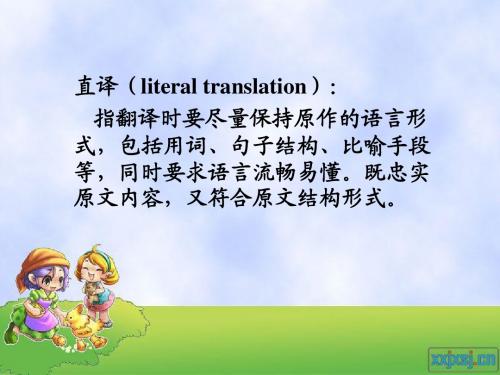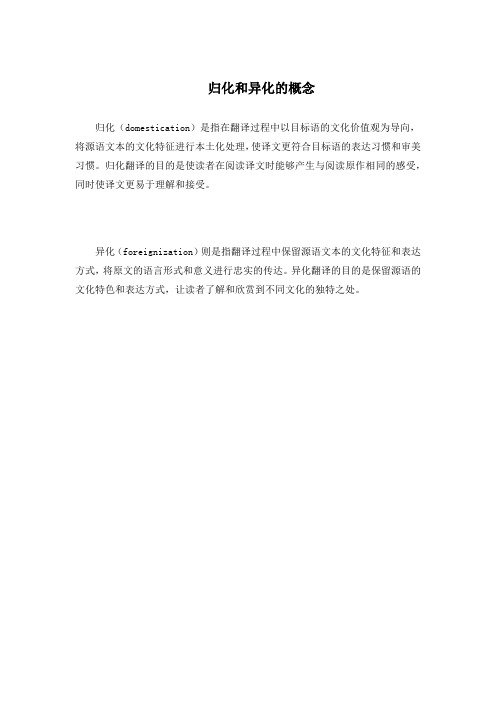归化翻译与异化翻译
中英互译中的异化法与归化法

中英互译中的异化法与归化法一、异化与归化的含义异化:指在翻译方法上迁就外来文化的特点吸纳外语表达方式。
Foreignization: refers to the characteristics of foreign cultures before the translation method, and absorbs foreign language expressions .归化:指恪守本族文化的语言传统,回归地道的本族语表达方式。
Domestication: the language tradition that abides by the native culture and the idiomatic expression of native language .二、翻译实例:1、A good teacher should have his head in the clouds sometimes , but his feet always on the ground .异化法翻译:一个好老师的头有时要放在云层中,但他的脚应该永远站在地上。
归化法翻译:一个好老师应该有时富于幻想,但时刻必须从实际出发。
2、Go to law for sheep , you lose a cow .异化法翻译:为了一只羊打官司,却损失了一头牛。
归化法翻译:捡了芝麻,丢了西瓜。
异化法: trump card王牌sour grapes酸葡萄grade inflation分数贬值归化法:talk horse吹牛at a stone’s throw近在咫尺,一箭之遥wet like a drown湿如落汤鸡as stupid as a goose蠢得像猪A big reward will make the brave come forward. 重赏之下,必有勇夫。
Only a headhunter like Bo Le---an ancient Chinese good at headhunting fine steeds---can discover talented people. 有伯乐而后得千里马。
翻译的归化和异化理论

例如: 1.Love me, love my dog. 爱屋及乌。 2.a lion in the way 拦路虎 3.lick one’s boots 拍马屁 4.Diamond cuts diamond 棋逢对手 5.A flash in a pan 昙花一现 6.Have one foot in the grave 风烛残年 7.To grow like mushrooms 雨后春笋 8.One boy is a boy,two boys half a boy,three boys nobody.一种和尚
Differences
However, this does not mean the two pairs are just one. There are some differences between them. When a translator resorts to either literal translating method or free translating method, he puts his attention mainly to the linguistic factors of the source text and tries his utmost to keep the original meaning in the target text.
Domestication refers to the target-culture-oriented translation in which unusual expressions to the target culture are exploited and turned into some familiar ones so as to make the translated text intelligible and easy for the target readers.
翻译——异化与归化

,甚至会出现某些意思丧失的 情况 。但在直译 、意译中 ,不论选用哪一种,原文的内容都会得到忠实的表达 。如林 纤翻译的作品 ,我们只能说是归化翻译,不能称之为意译 ,因为他对原文进行了很多改 写与创造。这是两对术语的区别之一。 2)直译与意译是翻译方法,而归化与异化是翻译策略,二者不在一个层 次 上 ,后者指 导前者。《现 代汉语词典》(修订本)说“方法”是“关于解决思想、说话、行动等问 题的门路 、程序等。”而“策略”是“根据形势发展而制定的行动方针和斗争方式 。” 方法和策略是有一定联系的,方法是策略指导下的具体做法,策略是指导方法的方针与 目标 。在归化和异化的指导下,译者选择与之相适应的译法,除直译 、意译外 ,还有夹 叙夹译 、音译 、编 译等多种方法。 因此,归化与异化跟直译与意译虽然有一定的联系,但也存在着明显的区别。把两 对术语混合使用 ,不利于范畴的规范化 ,不利于理论研究 ,也不利用于翻译实践 。
异 化 与 归 化
一 归化与异化的来源及其内涵
汉语中的归化与异化在英文中有两对术语与之对应:第一对是“assimilation and alienation”,第二对是“domestication and foreignization”。
1. assimilation and alienation
2. domestication and foreignization
这对术语由美国著名翻译家韦努蒂(L. Venuti)于1995年在《译者的隐身》 (The Translator’s Invisibility)中提出,是用以表述两种不同的翻译策略 (strategy)的。韦努蒂认为 domestication含有贬义,因为 “ it is identified with a policy common in dominant cultures which are ‘aggressively monolingual, unreceptive to the foreign ’, and which he describes as being ‘accustomed to fluent translations that invisibly inscribe foreign text with (target language) values and provides readers with narcissistic experience of recognizing their own culture in a cultural other’.”韦努蒂对domestication的界定与前面论及过的 assimilation并无本质上的区别,但我们不得不注意domestication有更深层的含 义。韦努蒂认为选择这一翻译策略的原因不仅是为了方便读者阅读,更重要的 是因为两种文化不平等,为此他提出了“强势文化”(dominant culture)的概念, 他认为强势文化的排外性与强制性是选用这一策略的最主要的原因。当弱势文 化的语言翻译成强势文化的语言(主要是英语)时,为了得到强势文化读者的接 受与认同,就必须选用他们所乐于接受的内容与形式。因此,domestication 的 这层含义用到翻译策略上,则是强势文化为达到对弱势文化殖民统治的目的与 需要,重组原文的语言与文化特点,使之符合强势语言与文化的规范。这层意思 assimilation没有。 关于foreignization,韦努蒂把它看作是对domestication翻译策略的挑战, 其作用是“register the linguistic and cultural difference of the foreign text, sending the reader abroad.”这样在翻译中保留原文语言和文化的特色,让译文
翻译的归化和异化理论

Foreignization is a source-culture-oriented translation which strives to preserve the foreign flavor as much as possible in order to transfer the source language and culture into the target one.
定义Definition
归化(domestication)是指在翻译中采用透明、流畅的风格,最 大限度地淡化原文的陌生感的翻译策略。它应尽可能的使源语文本 所反映的世界接近目的语文化读者的世界,从而达到源语文化与目 的语文化之间的“文化对等”。
归化法是以目的语文化为归宿的翻译方法, 是基于人类文化和语言 的个性而发展。要求译者向译语读者靠拢,采取译语读者习惯的译 语表达方式,来传达原文的内容;
例子
① 异化可以在语音层上出现。例如: ballet译作“芭蕾舞” cigar译作“雪茄” laser过去译成“莱塞”,现译作“镭射”、“激光” 目前大街小巷都风行的“卡拉 OK”等。
② 异化可以在词语层出现。例如: “crocodile tears”译作“鳄鱼的眼泪” “an olive branch”译作“橄榄枝” “sour grapes”译作“酸葡萄” “the cold war”译作“冷战ove my dog. 爱屋及乌。 2.a lion in the way 拦路虎 3.lick one’s boots 拍马屁 4.Diamond cuts diamond 棋逢对手 5.A flash in a pan 昙花一现 6.Have one foot in the grave 风烛残年 7.To grow like mushrooms 雨后春笋 8.One boy is a boy,two boys half a boy,three boys nobody.一个和尚
翻译归化异化

好是很好,可是买这么多扇子干什么呀?
A: Good is very good,but buy so many fans do What? B: It is good, but why do you buy so many fans?
【意译2】她觉得跟他在一起比跟谁都开心。 【意译3】她觉得跟他在一起最开心了。
【意译4】她觉得最开心的事,就是跟他在一起。
【意译5】她喜欢跟他在一起,(因为)那是最开心的事。 上面的直译都不是“明白易懂的中国话”,因为原句的
语内翻译本来是:She liked to be with him,which is
意译 (free translation; paraphrase; liberal translation) 意译是指从意义出发,只要求将原文大意表达
出来,不注意细节,译文自然流畅即可。意译不 注重原作形式,包括句法结构、用词、比喻以及 其他修辞手段。意译主 要在原语与译语体现巨 大文化差异的情况下得以应用。
乡亲们,你们受苦了!
Folks, you have suf fered a lot!
死译:
Though the flowers are very beautiful, you sck them
The flowers are so fair, And they need your care!
意译和乱译
只有在正确理解原文基础上,运用相 应翻译方法以调整原文结构,用规范汉语 加以表达,这才真正做到“意译”。翻译 实践证明,大量英语句子汉译都要采取 “意译法”。 如果把“意译”理解为凭主观臆想来 理解原文,可以不分析原文结构,只看词 面意义,自己编造句子,势必造成“乱 译”。如:
归化和异化的概念

归化和异化的概念
归化(domestication)是指在翻译过程中以目标语的文化价值观为导向,将源语文本的文化特征进行本土化处理,使译文更符合目标语的表达习惯和审美习惯。
归化翻译的目的是使读者在阅读译文时能够产生与阅读原作相同的感受,同时使译文更易于理解和接受。
异化(foreignization)则是指翻译过程中保留源语文本的文化特征和表达方式,将原文的语言形式和意义进行忠实的传达。
异化翻译的目的是保留源语的文化特色和表达方式,让读者了解和欣赏到不同文化的独特之处。
谈跨文化翻译中的归化翻译与异化翻译

谈跨文化翻译中的归化翻译与异化翻译一、引言归化翻译(domesticating translation)与异化翻译(foreignizing translation)是美国学者劳伦斯·韦努蒂在1995年所著的《译者的隐身》(Translator’s Invisibility)一书中首次提出的。
根据韦努蒂的界定,归化翻译是译者为了制造出透明、通顺的译文而将异域文本中的“陌生性”降低到最低程度的翻译策略。
而异化翻译是译者为了故意对目的语文化的规范进行冲击而保留原作中一些“陌生性”的翻译策略。
可见,归化翻译主要是遵循目的语文化当前的主流价值观,翻译时以目的语文化为归宿,将读者立于核心地位,充分考虑读者的文化背景,信息接受心理与接受习惯。
尤金·奈达(E u g e n e A Nida)是推崇归化翻译的代表人物。
他认为,“翻译即是交流,这个过程要看人们在听、说、读译文时所获得的是什么。
判断一个译本的效用不宜拘于相应的词汇意义、语法类别和修辞手段的对比,重要的是考察接受者正确理解和欣赏译语文本的程度。
”奈达认为成功的翻译就是要使译语读者产生与源语读者类似的反应。
而归化翻译能使读者更好地理解原文,避免文化冲突,从而达到文化交流的目的。
异化翻译的前提是:认为文化是有差异的。
主张异化的译者,不仅可以在译文的表达手段上异化,而且会选择对目的语中的外国文学规范提出挑战的外国文本来翻译。
劳伦斯·韦努蒂本人就是异化翻译的代表人物。
他提出了“反翻译”的概念。
这种翻译刻意在目的语的文本中, 在风格和其它方面突出原文之“异”。
劳伦斯·韦努蒂公开声言:“其目的是要发展一种翻译理论和实践,以抵御目的语文化占指导地位的趋势,从而突出文本在语言和文化这两方面的差异。
”归化翻译和异化翻译是当前翻译界近年来争论的热门话题,本文将从跨文化翻译的角度对这两种翻译策略做一对比,并探讨如何在两者之间寻找到平衡点。
跨文化视野中的归化翻译与异化翻译——以Gone with the Wind不同译本为例

2019年17期总第457期翻译研究ENGLISH ON CAMPUS跨文化视野中的归化翻译与异化翻译——以Gone with the Wind不同译本为例文/徐 秋【摘要】翻译是一种跨语言、跨文化、跨社会的交际活动。
纵观全球形势,不难发现全球化现象日益显现。
我们的当务之急便是相互理解、相互学习。
著名翻译理论学家劳伦斯韦努蒂早期提出“归化”与“异化”翻译策略为传递文化做出了巨大贡献。
而归化和异化则是缓和源语文化和译语文化矛盾的主要策略,这两者之间对立统一,相辅相成。
归化是对原文的一种“再创造”,突破了原作的禁锢,使译文更加较读者接受;异化则是忠于原作,保留异国风俗习惯和语言表达习惯,使读者体会到真切的异国风情。
本文将从跨文化视野下讨论归化异化翻译并且以Gone with the Wind不同译本为例予以分析。
【关键词】跨文化;归化;异化;翻译;Gone with the Wind【作者简介】徐秋(1996-),女,河南信阳人,汉族,沈阳理工大学外国语学院英语笔译专业在读研究生,研究方向:英语笔译。
一、语言文化与跨文化翻译1.翻译与跨文化交际。
所谓文化,一般则囊括了一个民族的知识,宗教,信仰,思维方式等等;而任何一个民族的文化都有其独特的性质,源远流长,不可磨灭。
这些特性渗透在其日常生活的方方面面,如艺术修养,政治思想,风俗习惯等。
不同民族不同文化之间的碰撞即跨文化交际。
2.跨文化翻译中应重视语言文化的影响。
笔者认为,文化是我们在讨论跨文化翻译时必须考虑的因素,跨文化翻译必须存在两种或者两种以上的语言也即是文化。
语言隶属于文化,两者之间关系密切,相比较而言,文化更加宽泛。
正所谓词本无意,因境而生。
此外,翻译趋向于向读者介绍异国的优秀文学作品,旨在传播文化。
3.不同背景下,翻译策略的选择。
在现实的翻译实践中,不同的文化和语言产生文化隔阂是不可避免的,在交际中阻碍信息的传播。
因此译者将面临着抉择即,再创造还是保留异国风情。
- 1、下载文档前请自行甄别文档内容的完整性,平台不提供额外的编辑、内容补充、找答案等附加服务。
- 2、"仅部分预览"的文档,不可在线预览部分如存在完整性等问题,可反馈申请退款(可完整预览的文档不适用该条件!)。
- 3、如文档侵犯您的权益,请联系客服反馈,我们会尽快为您处理(人工客服工作时间:9:00-18:30)。
Definition
• DT is a translation strategy in which a transparent, fluent style is adopted in order to minimize the strangeness of the foreign texts for target language readers.
Foreignizing Translation and Domesticating Translation
异化翻译与归化翻译
History of FT & DT
• German scholar Friedrick Schleiermacher The translator can either leave the writer in peace as much as possible and bring the reader to him ,or he can leave the reader in peace as much as possible and bring the writer to hime. (1813)
Its opposite is literal translation. A free translation can be either a domesticating translation, or a foreignizing translation or neither of them. If it retains the foreign flavor, it is a foreignizing translation. If it loses the exotic flavor and is biased toward the target language-culture, it is a domesticating translation. If it loses the original flavor and is not biased toward the target side, it is neither of them.
Italian-origined American scholar Lawrence Venuti
“The Translator’s Invisibility ”
FT and literal translation
• Literal translation refers to either a strategy or a product. It focuses on the reproduction of both the form and meaning of the ST although the form sometimes does not conform to the target language usage. Word-for-word, or verbatim translation, is a special case of literal translation. The corresponding act is labeled “translate literally or directly or verbatim”.
DT and free translation
• Free translation, also called liberal translation, refers to either a strategy or a product. It focuses on the reproduction of the ST meaning rather than its form. The corresponding act is labeled “free-translate” or “free-hand”. The result of the act is a free translation. The translator who advocates it is a liberalist or a free-hander. Their thought or perception of translation is liberalism.
• FT is a type of translation in which a target text “deliberately ” breaks target conventions by retaining something of the foreignness of the original.
The result of the act is a literal translation. The translator who advocates it is a literalist. Their thought or perception of translation is literalism. Its opposite is free translation. A literal translation is a foreignizing translation in cases where source and target language and culture systems conflict with each other.
• Schleiermacher claimed :
Translations from different languages into German should read and sound different :the reader should be able to ,guess the Spanish behind a translation from Spanish ,and the Greek behind a translation from Greek
